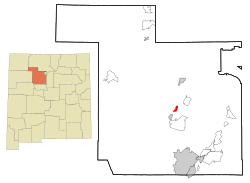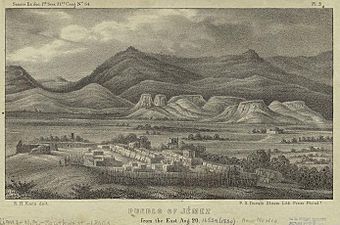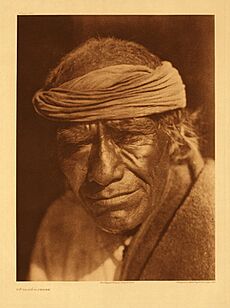Jemez Pueblo, New Mexico facts for kids
Quick facts for kids
Jemez Pueblo, New Mexico
|
|
|---|---|
| Motto(s):
The Gateway of the Jemez World
|
|

Location of Jemez Pueblo, New Mexico
|
|
| Country | United States |
| State | New Mexico |
| County | Sandoval |
| Area | |
| • Total | 2.05 sq mi (5.31 km2) |
| • Land | 2.04 sq mi (5.30 km2) |
| • Water | 0.01 sq mi (0.01 km2) |
| Elevation | 5,555 ft (1,693 m) |
| Population
(2020)
|
|
| • Total | 1,963 |
| • Density | 960.37/sq mi (370.72/km2) |
| Time zone | UTC-7 (Mountain (MST)) |
| • Summer (DST) | UTC-6 (MDT) |
| ZIP code |
87024
|
| Area code(s) | 575 |
| FIPS code | 35-35250 |
| GNIS feature ID | 2408443 |
|
Jemez Pueblo
|
|

Jemez Pueblo, 1850 illustration
|
|
| Lua error in Module:Location_map at line 420: attempt to index field 'wikibase' (a nil value). | |
| Nearest city | Bernalillo, New Mexico |
| Area | 124 acres (50 ha) |
| Built | 1700 |
| Architectural style | Late Victorian, Pueblo |
| NRHP reference No. | 77000926 |
| Significant dates | |
| Added to NRHP | May 2, 1977 |
Jemez Pueblo is a special community in New Mexico, USA. It's known as a census-designated place (CDP). This means it's a place where people live that's counted by the government, but it's not officially a city or town. Jemez Pueblo is located in Sandoval County. In 2020, about 1,963 people lived there. It is part of the larger Albuquerque area.
The community gets its name from the historic pueblo (village) at its center. The people of Jemez Pueblo call their home Walatowa in their own language. It is believed that a historic mission, the Mission San Diego de la Congregacion, was once located here.
Contents
Geography of Jemez Pueblo
Jemez Pueblo is a beautiful place. It covers about 2 square miles (5.3 square kilometers) of land. There is almost no water area within the community. The area is known for its stunning "Red Rocks" formations.
People of Jemez Pueblo
The people of Jemez Pueblo have a rich history. Many residents are descendants of the Pecos Pueblo people. They came to Jemez Pueblo in 1838 after their own community faced challenges.
Language and Culture
The Jemez people speak a unique language. It is called Jemez or Towa. This language belongs to the Kiowa–Tanoan language family. It is an important part of their cultural identity.
Population Facts
In 2020, the population of Jemez Pueblo was 1,963 people. Most residents are Native American. A small percentage are White or from other backgrounds. About 2% of the population identifies as Hispanic or Latino.
The community has many families. In 2000, about 39% of households had children under 18. The average household had about four people. The median age in Jemez Pueblo was 28 years old. This means it is a community with many young people and families.
Daily Life and Income
In 2000, the average income for a household was around $28,889 per year. For families, it was about $30,880. About a quarter of the population lived below the poverty line. This included many children and elders.
Traditional Uses of Plants
The Jemez people have a deep connection to nature. They consider a plant called Carex to be very special. They use this plant in their sacred kiva ceremonies. This shows how important plants are to their traditions.
Jemez Runners: A Proud Tradition
Running has always been a significant part of Jemez culture. It is both a fun pastime and a ceremonial activity. Before televisions became common, stories of amazing running feats were a popular way to entertain people during winter nights.
Running in Ceremonies
Races continue to be important in ceremonies. They are sometimes held to help the sun and moon move. They can also be used to encourage crops to grow faster. This shows how running connects to their beliefs and way of life.
Running as a Sport
Over time, running also became a popular sport. In 1959, the first annual Jemez All-Indian Track and Field Meet was held. Runners from Jemez won this event seven times in the first ten years. A famous Jemez runner named Steve Gachupin won the Pikes Peak Marathon six times. In 1968, he set a record by reaching the top in just 2 hours, 14 minutes, and 56 seconds. This shows the incredible talent of Jemez runners.
Education in Jemez Pueblo

Children in Jemez Pueblo attend schools in the Jemez Valley Public Schools district. There is also a special school called Jemez Day School. It is an elementary school run by the Bureau of Indian Education. This school helps provide education for the children of Jemez Pueblo.
Notable People from Jemez Pueblo
Many talented individuals come from Jemez Pueblo.
- Cliff Fragua is a well-known sculptor.
- James Madalena served as a member of the New Mexico House of Representatives.
- N. Scott Momaday was a famous writer. He won the Pulitzer Prize for Fiction.
- Benny Shendo is a member of the New Mexico Senate.
- Mary Ellen Toya (1934–1990) was a gifted artist.
- Evelyn M. Vigil is also a notable artist.
Images for kids
See also
 In Spanish: Jemez Pueblo para niños
In Spanish: Jemez Pueblo para niños




